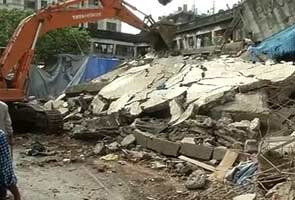
Mumbai:
Seven people, most of them vegetable vendors, lost their lives when a 30-year-old building, listed as dangerous by the civic body, collapsed in the far-flung Mumbai suburb of Dahisar.
It's the fourth building collapse in Mumbai in less than three months. On Friday, a three-storeyed residential building crashed in Thane's Mumbra killing 10 people.
While no one lived in the building at Dahisar, many vegetable vendors had their stalls by its walls. And being the rainy season, many had taken shelter inside it.
Kamlesh Kachalia, a housewife who lives in a building nearby said, at around 6:30 am she heard a loud crash. "I yelled to my husband who said the Piyush Building has come crashing down. It was a really rundown building. But we never imagined it would crash", she said.
National Disaster Response Force's (NDRF) Assistant Commandant S Ahmed, spearheading the search and rescue operations, said an operation like this has its own typical challenges. "This building was inhabited by stray labourers without families. So we are finding it tough to carry out a head count and determine how many people might be trapped," he said.
Built in 1983, the building was evacuated in 2010 by the Brihanmumbai Municipal Corporation (BMC) because it was structurally unsound.
Lalit Kumar Jain, once a resident of Piyush Building, says they had even warned the vegetable vendors not to sit along and inside the empty building because it was shaky. "We even placed a watchman there to prevent people from going in. We had even reported it to the cops so that no one could enter the building. The hawkers would move out for two-three days and then return."
In fact, a watchman placed at the site, Mansingh, lost his wife and his daughter and her husband in the collapse.
"In 2006 itself the building had developed huge cracks. That's because it was not really a residential building. Many of the rooms were workshops for diamond polishing and cutting, so heavy machinery was placed in the building which was not built for industrial work," says Vivek Sthalekar, a secretary of the Flat Owners Organisation of Dahisar. He blames Nemji Gangar, the builder for the collapse and has complained to the local Dahisar police station.
The Mumbai civic authorities have identified 949 very dangerous buildings in the city, particularly dangerous during the monsoon as rains can weaken an already unsteady structure.
Bombay Municipal Commissioner Sitaram Kunte, who was at the site, said it's a challenge for the BMC to evacuate dangerous buildings. "Residents in those buildings put up a stiff resistance because they just don't want to leave their homes. They are determined to stay on even if the building is dangerous. So we are trying to force them out now by cutting electricity and water supply but it is still not easy."
Civic authorities have mandated that all buildings in Mumbai that are over 30-years-old conduct a structural audit every five years.
"Finally residents must take some responsibility for their safety", says the civic chief.
It's the fourth building collapse in Mumbai in less than three months. On Friday, a three-storeyed residential building crashed in Thane's Mumbra killing 10 people.
While no one lived in the building at Dahisar, many vegetable vendors had their stalls by its walls. And being the rainy season, many had taken shelter inside it.
Kamlesh Kachalia, a housewife who lives in a building nearby said, at around 6:30 am she heard a loud crash. "I yelled to my husband who said the Piyush Building has come crashing down. It was a really rundown building. But we never imagined it would crash", she said.
National Disaster Response Force's (NDRF) Assistant Commandant S Ahmed, spearheading the search and rescue operations, said an operation like this has its own typical challenges. "This building was inhabited by stray labourers without families. So we are finding it tough to carry out a head count and determine how many people might be trapped," he said.
Built in 1983, the building was evacuated in 2010 by the Brihanmumbai Municipal Corporation (BMC) because it was structurally unsound.
Lalit Kumar Jain, once a resident of Piyush Building, says they had even warned the vegetable vendors not to sit along and inside the empty building because it was shaky. "We even placed a watchman there to prevent people from going in. We had even reported it to the cops so that no one could enter the building. The hawkers would move out for two-three days and then return."
In fact, a watchman placed at the site, Mansingh, lost his wife and his daughter and her husband in the collapse.
"In 2006 itself the building had developed huge cracks. That's because it was not really a residential building. Many of the rooms were workshops for diamond polishing and cutting, so heavy machinery was placed in the building which was not built for industrial work," says Vivek Sthalekar, a secretary of the Flat Owners Organisation of Dahisar. He blames Nemji Gangar, the builder for the collapse and has complained to the local Dahisar police station.
The Mumbai civic authorities have identified 949 very dangerous buildings in the city, particularly dangerous during the monsoon as rains can weaken an already unsteady structure.
Bombay Municipal Commissioner Sitaram Kunte, who was at the site, said it's a challenge for the BMC to evacuate dangerous buildings. "Residents in those buildings put up a stiff resistance because they just don't want to leave their homes. They are determined to stay on even if the building is dangerous. So we are trying to force them out now by cutting electricity and water supply but it is still not easy."
Civic authorities have mandated that all buildings in Mumbai that are over 30-years-old conduct a structural audit every five years.
"Finally residents must take some responsibility for their safety", says the civic chief.
Track Latest News Live on NDTV.com and get news updates from India and around the world

